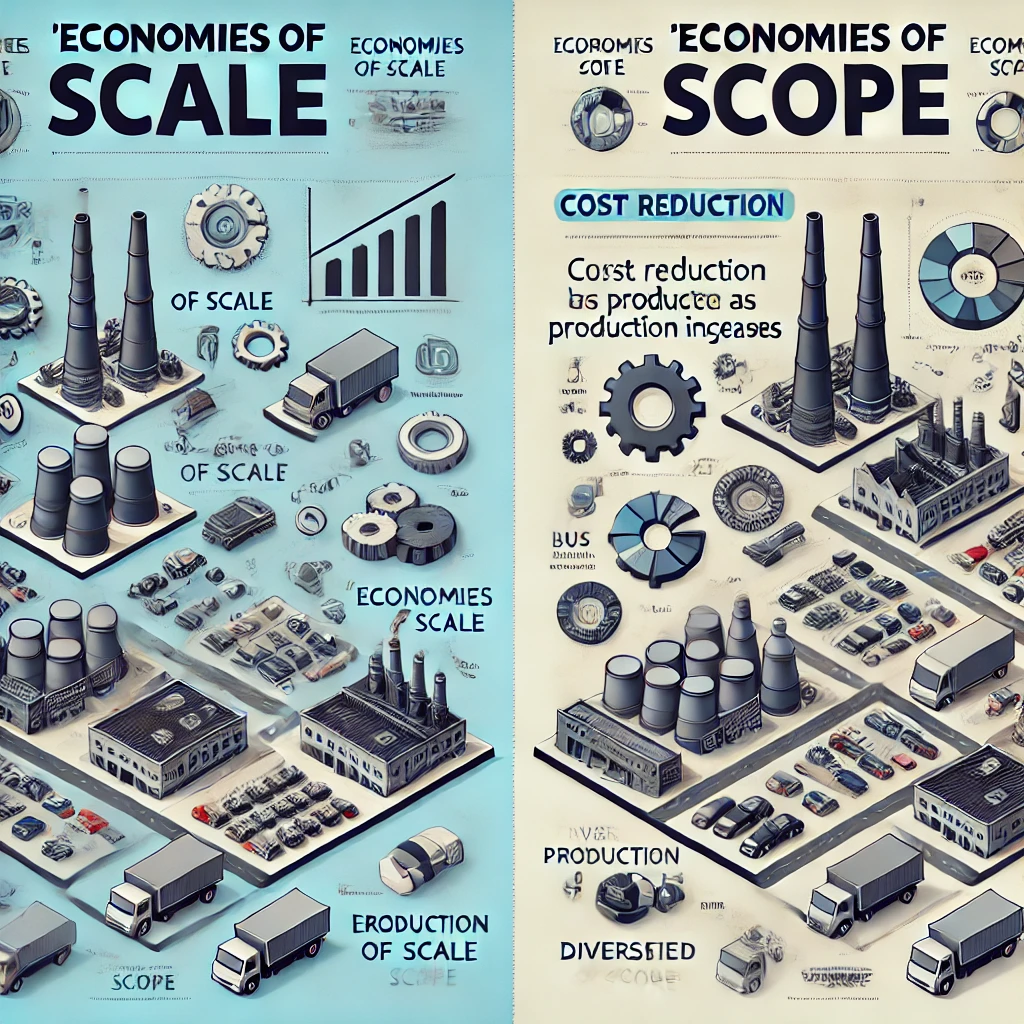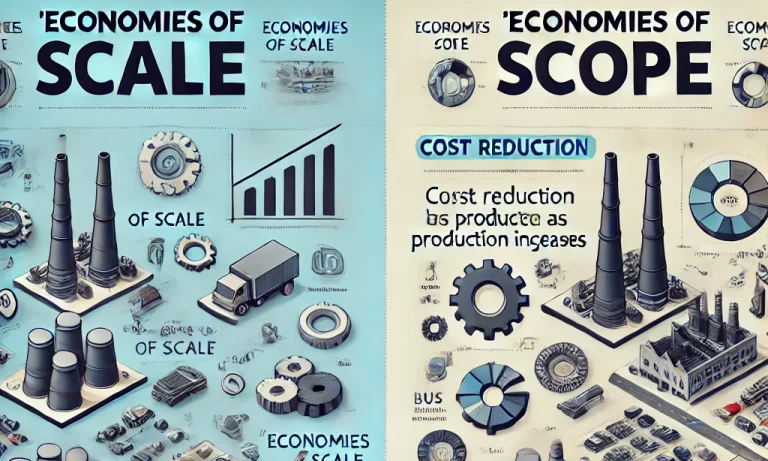Companies must recognize economies of size and scope in today’s business environment since they serve as the foundation for competitive strategies. Operational efficiency is based on these two ideas. They assist businesses in turning a profit while keeping expenses down. These economies give businesses the opportunity to grow sustainably and gain better market positions.
Economies of scale and economies of scope are two concepts found in the basic fabric of economics and business strategy. While they both deliver cost efficiency, they do so through different focuses and means. Economies of scale derive cost savings through the increase in volume of production. Whereas economies of scope derive it through diversification or sharing of resources. Now, let’s read the two concepts in depth.
Difference Between Economies of Scale and Economies of Scope
Economies of scale and scope address cost efficiency from different dimensions—production volume versus product diversity.
| Aspect | Economies of Scale | Economies of Scope |
|---|---|---|
| Definition | Cost savings due to increased production volume | Cost savings by diversifying or sharing resources |
| Focus | Quantity of output | Variety of products/services |
| Application | Large-scale production units | Multi-product/service firms |
| Example | A car manufacturer reducing per-unit costs by producing more cars | A company leveraging a single marketing team for multiple brands |
| Dependency | Fixed cost dilution over more units | Resource sharing or joint processes |
| Risks | Overproduction and diseconomies of scale | Complexity in management and loss of specialization |
| Drivers | Technological advancements, bulk purchasing | Shared overheads, complementary goods production. |
Economies of Scale Meaning
Economies of scale arise when businesses lower their per-unit production cost through increased production volume. It arises because of fixed costs, such as infrastructure and equipment. And are spread over a larger number of goods.
The following are characteristics of economies of scale:
- Reducing costs: A business can spread the fixed costs. These include overhead expense or equipment, over a more significant output. Cost per unit production is decreased.
- Production efficiency: Large-scale production allows companies to take advantage of specialized equipment, large-order purchasing, and greater process efficiency. Thereby getting more output.
- Competitive advantage: With the help of economies of scale, businesses could reduce their prices, increase market share, and have an edge in competition over the smaller competitors.
Relation in Economies and Diseconomies of Scale
While economies of scale focus on cost efficiency, increasing production indefinitely can lead to diseconomies of scale. Diseconomies of scale occur when the per-unit cost begins to rise due to inefficiencies such as:
- Overloaded management systems.
- Supply chain constraints.
- Worker demotivation due to excessive workloads.
What Is Internal and External Economies of Scale?
Economies of scale are cost benefits a firm enjoys when it expands its output. Economies of scale can be classified into two: internal economies of scale and external economies of scale. Thereby, depending on whether they occur from internal factors within the organization or external factors of the business, industry, or economy.
Internal Economies of Scale
Internal economies of scale originate within a company. They are a direct result of its expansion. As the scale of operations grows, businesses can achieve lower per-unit costs. And through efficient resource use, advanced technologies, and optimized production processes.
Types of Internal Economies of Scale:
- Technical Economies
- Managerial Economies
- Financial Economies
- Marketing Economies
- Purchasing Economies
- Risk-Bearing Economies
External Economies of Scale
The external economies of scale result from factors outside the firm. This is because of the industry’s growth or improvements in the surrounding environment. Such economies add to all the firms within a particular industry.
Types of External Economies of Scale
- Industry Growth
- Infrastructure Development
- Knowledge Spillovers
- Labor Pooling
Examples:
- Development of infrastructure around an industrial zone.
- Reduction in input costs as suppliers increase efficiency.

What Is Economies of Scope?
Economies of scope refer to the cost advantages that a firm can get in producing two or more goods or services together. Due to common resources, infrastructure, or expertise in other product lines or operations. The diversification of offerings gives rise to average costs per unit of production. Moreover, firms tend to appropriate such synergies between different products.
Types of Economies of Scope
Economies of scope arise when businesses save costs by producing many products or offering a range of services using shared resources, infrastructure, or expertise. These efficiencies allow companies to diversify their product lines while maintaining cost-effectiveness. Below are the detailed types of economies of scope, along with examples.
1. Product Economies of Scope
Product economies of scope occur when the same firm manufactures different products sharing common inputs or processes, raw materials, or technology. Hence, its primary focus is minimizing the production process costs by applying cumulative inputs or facilities.
Examples:
- A bakery produces cakes, bread, and pastries using the same ingredients and ovens.
- A tech company produces both laptops and tablets using shared components like processors and screens.
2. Operational Economies of Scope
When companies share operational processes or systems across various product lines, it achieves economies of scope. Thus, operational economies of scope are applied as sharing manufacturing plants/logistics networks/ human resources to streamline operations.
Examples:
- A fast-food chain preparing burgers, fries, and drinks in a single outlet with shared staff and equipment.
- A software company using a unified platform to deliver different types of applications.
3. Financial Economies of Scope
These economies arise because firms diversify their investments or take financial resources across businesses. Thus, lowers capital costs and reduces financial risk. Large firms can also centralize financial management systems to save administrative expenses.
Examples:
- A conglomerate manages diverse portfolios to stabilize revenues during economic fluctuations.
- A multinational corporation uses centralized finance departments for various subsidiaries, reducing administrative costs.
4. Marketing Economies of Scope
Marketing economies of scope underlie cost efficiencies by marketing several products under the same campaign or brand. A strong brand would be able to support several product lines since a brand retains low costs in advertising and promotion.
Examples:
- A cosmetics company advertising skincare and makeup products together.
- A lifestyle brand promoting apparel and accessories through combined marketing campaigns.
5. Technological Economies of Scope
Technological economies of scope arise when technological innovations or investments benefit many product lines. Economies of scope can arise if common R&D or other technological infrastructure leads to breakthroughs applicable to some products.
Examples:
- A pharmaceutical company developing a drug whose formula is adapted for different conditions.
- A tech company uses the same operating system across various devices like phones, tablets, and smart TVs.
6. Knowledge-Based Economies of Scope
Knowledge-based economies of scope arise when the expertise, intellectual property, or know-how are pooled across business areas. This one relies more on intangible assets, such as skills, patents, and managerial experience, to realize cost savings.
Examples:
- A university offering online courses in diverse fields using shared technology platforms.
- A consulting firm leveraging its knowledge in finance, HR, and strategy for cross-functional projects.
Conclusion
Understanding the differences between economies of scale and economies of scope helps businesses to plan strategies that contribute toward sustainable growth. Economies of scale focus on achieving efficiency through a higher production level. Whereas economies of scope concentrate on diverging and shared resource optimization. By leveraging both, effective companies can look for competitive advantages in today’s dynamic market diversification and shared resource optimization. By leveraging both effectively, companies can achieve a competitive edge in today’s dynamic market.
Economies of Scale and Economies of Scope FAQ
What are the risks of economies of scope?
The primary risks include increased complexity in operations and potential loss of focus on core competencies.
How can businesses balance economies of scale and scope?
Organizations must assess their resources and market demands to find an optimal balance between scaling operations and diversifying offerings.
What industries benefit most from economies of scale?
Industries with high fixed costs, such as manufacturing and energy, gaining the most from economies of scale.
Can economies of scale lead to monopolies?
Yes, as larger companies reduce costs, smaller competitors may struggle to compete. It leads to industry monopolization.
How do economies of scale and scope drive profitability?
Economies of scale reduce unit costs, while economies of scope maximize resource use, enhancing profitability.


